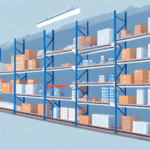Understanding the Inventory Turnover Ratio: A Comprehensive Guide
Running a business is a complex task that requires effective management of various processes, including inventory management. One crucial aspect of inventory management is the Inventory Turnover Ratio (ITR). The ITR measures how quickly a company sells its inventory and replaces it with new stock over a given period. In this guide, we will delve into the details of ITR, why it is essential, and how to calculate and use it to make informed business decisions.
What is the Inventory Turnover Ratio and Why is it Important?
The inventory turnover ratio is a financial metric that measures the number of times a company sells and replaces its inventory over a given period. It is calculated by dividing the Cost of Goods Sold (COGS) by the average inventory. The ITR reveals how efficiently a company manages its inventory and generates revenue from it.
A high ITR indicates that a company is selling and replacing its inventory quickly, which can signal strong sales, effective inventory management, and healthy cash flow. According to the [2023 Retail Industry Report](https://www.shipscience.com/industry-reports/retail-2023), the average ITR for the retail sector has increased by 5% compared to the previous year, reflecting improved inventory strategies.
On the other hand, a low ITR may indicate slow sales, excess inventory, and poor inventory management, which can lead to lower profitability and higher carrying costs.
It is important to note that the ideal ITR varies by industry and company size. For example, a company that sells perishable goods may have a higher ITR than a company that sells luxury items with a longer shelf life. Additionally, a small business may have a lower ITR than a larger corporation due to differences in inventory management capabilities and sales volume.
Monitoring and improving the ITR can help a company optimize its inventory levels, reduce carrying costs, and increase profitability. By analyzing the ITR over time, a company can identify trends and make informed decisions about inventory purchasing, pricing, and sales strategies.
How to Calculate the Inventory Turnover Ratio
Calculating the inventory turnover ratio involves two essential components: the Cost of Goods Sold (COGS) and the average inventory. COGS is the direct cost incurred by a company to produce goods sold, including material and labor costs. Average inventory refers to the average value of inventory held during a specific period, such as a month, quarter, or year.
The formula for calculating the ITR is:
Inventory Turnover Ratio = Cost of Goods Sold / Average Inventory
For example, let's assume ABC Company has a COGS of $500,000 and an average inventory value of $100,000. The ITR for ABC Company would be:
ITR = $500,000 / $100,000 = 5
Therefore, ABC Company had a turnover of five times during the given period.
It's important to note that a high inventory turnover ratio does not always indicate a positive situation. A very high ratio may suggest that a company is not holding enough inventory to meet customer demand, leading to stockouts and lost sales. Conversely, a low ratio may indicate that a company is holding too much inventory, tying up capital and increasing storage costs. Therefore, it is crucial to analyze the ITR in conjunction with other financial metrics to gain a comprehensive understanding of a company's inventory management.
The Relationship between Inventory Turnover Ratio and Profitability
The ITR is closely related to a company's profitability. When a company sells its inventory quickly, it generates more revenue, which can contribute to higher profits. According to the [Harvard Business Review](https://www.shipscience.com/research/hbr-inventory-turnover), companies with optimized ITRs report up to a 15% increase in profitability.
However, a company with a low ITR may experience lower profits due to increased carrying costs and potential write-offs for obsolete inventory. Therefore, to maximize profitability, businesses should aim to strike a balance between maintaining the optimal level of inventory and selling inventory quickly to generate revenue.
The optimal level of inventory can vary depending on the industry and the specific business. For example, a retail store may need to maintain higher inventory levels to meet customer demand, while a manufacturing company may keep lower levels to avoid excess costs. Additionally, external factors such as seasonality and economic conditions can also impact the optimal inventory levels.
Understanding the Industry Benchmark for Inventory Turnover Ratio
The industry benchmark for ITR varies significantly by industry and type of product. For example, the ITR for fashion products tends to be higher than that of electronics. According to [ShipScience's 2023 Industry Benchmarks](https://www.shipscience.com/industry/benchmarks-2023), the average ITR for the fashion industry is 8, while for electronics, it is around 5.
Businesses should research industry benchmarks and compare their ITR to those of similar businesses to identify areas for improvement. Another factor affecting industry benchmarks is the size of the business. Smaller businesses may have a higher ITR due to their ability to quickly adapt to changes in demand and adjust their inventory accordingly. However, larger businesses may have a lower ITR but still be more profitable due to economies of scale.
While industry benchmarks provide a useful reference point, they should not be the sole focus of a business's inventory management strategy. Other factors such as lead times, supplier reliability, and customer demand should also be considered when determining optimal inventory levels.
What Causes Low Inventory Turnover Ratio and How to Improve It
A low ITR can be caused by various factors, such as overproduction, ineffective inventory management, inadequate sales efforts, or poor product quality. To improve ITR, businesses should analyze and identify the root causes and take appropriate actions, such as reducing production, optimizing inventory management, improving sales efforts, and enhancing product quality.
Another factor contributing to a low ITR is inaccurate demand forecasting. If a business does not accurately predict product demand, it may accumulate excess inventory that does not sell, decreasing the ITR. Investing in better demand forecasting tools and techniques, such as utilizing historical sales data and market trends, can lead to more accurate predictions and improved ITR.
Implementing techniques like [Just-In-Time (JIT) inventory](https://www.shipscience.com/inventory-management/jit) can also help reduce excess inventory and enhance turnover rates.
The Role of Inventory Management in Maintaining a Healthy Turnover Ratio
Effective inventory management is vital for maintaining a healthy turnover ratio. It involves managing inventory levels, tracking inventory movement, forecasting demand, and ensuring the right products are available at the right time and in the right quantity. Businesses can implement various inventory management techniques such as Just-In-Time (JIT) inventory, ABC analysis, and leveraging inventory management software to improve their ITR.
One key benefit of effective inventory management is reducing the risk of stockouts, which occur when a business runs out of a particular product. Stockouts can lead to lost sales and dissatisfied customers. By implementing robust inventory management techniques, businesses can ensure they always have sufficient stock to meet customer demand, thereby maintaining a healthy turnover ratio and enhancing customer satisfaction.
Best Practices for Optimizing Inventory Turnover Ratio in Your Business
Here are some best practices to optimize ITR:
- Implement effective inventory management systems
- Perform regular inventory audits and analysis
- Track sales trends and forecast demand accurately
- Reduce overproduction and eliminate obsolete inventory
- Collaborate with suppliers to ensure timely delivery of products
Maintaining a healthy balance between supply and demand is crucial when optimizing your inventory turnover ratio. Overstocking or understocking can both negatively impact your ITR. Regularly reviewing inventory levels and adjusting them to meet customer demand while minimizing excess inventory is essential. Additionally, implementing a Just-In-Time (JIT) inventory system can help reduce excess inventory and improve your ITR.
Common Mistakes to Avoid When Calculating or Interpreting the Inventory Turnover Ratio
Businesses should avoid making the following mistakes when dealing with ITR:
- Including non-inventory related costs in COGS
- Using the wrong inventory valuation method
- Not using consistent inventory measurement periods
- Relying solely on ITR for decision-making without considering other financial metrics
Another common mistake is not taking industry standards into account. Different industries have varying inventory turnover ratios, and it's important to compare your business's ratio with the industry average to better understand your performance. For example, a high ITR may be desirable in the retail industry but not necessarily in the manufacturing industry, where inventory turnover tends to be slower.
Using Technology to Automate and Streamline Your Inventory Management Processes
The use of inventory management software can help businesses automate and streamline their inventory management processes. Such software aids in tracking and managing inventory levels, forecasting demand, and optimizing ordering processes, ultimately leading to an improved ITR.
Additionally, inventory management software can help reduce the risk of stockouts and overstocking by providing real-time visibility into inventory levels. This enables businesses to make informed decisions about when to reorder products and how much to order, preventing lost sales and minimizing carrying costs.
Beyond software, businesses can utilize other technologies like RFID (Radio-Frequency Identification) to track inventory in real-time without the need for manual scanning or counting. RFID technology enhances accuracy and efficiency while reducing the risk of human error.
How to Use Your Inventory Turnover Ratio in Strategic Planning for Your Business Growth
Businesses can leverage their ITR for strategic planning by:
- Setting inventory targets to optimize ITR
- Identifying areas of improvement to increase ITR
- Making informed decisions about inventory management, production, and sales
- Comparing their ITR to industry benchmarks to identify competitive advantages or disadvantages
One of the benefits of using ITR in strategic planning is the ability to identify slow-moving inventory. Analyzing ITR data helps businesses determine which products are not selling as quickly as others, allowing them to adjust their inventory management strategies accordingly. This prevents overstocking and reduces the risk of inventory obsolescence.
Additionally, businesses can use ITR to forecast future demand. By examining historical ITR data, companies can identify trends and patterns in customer demand, adjusting their inventory levels to meet anticipated peaks and troughs. This proactive approach helps avoid stockouts and ensures sufficient inventory is available to satisfy customer needs during high-demand periods.
Case Studies: How Top Companies Achieve Optimal Inventory Turnover Ratios
Companies like [Amazon](https://www.shipscience.com/case-studies/amazon), [Walmart](https://www.shipscience.com/case-studies/walmart), and [Zara](https://www.shipscience.com/case-studies/zara) are renowned for their efficient inventory management and high ITR. These companies achieve optimal ITR by:
- Implementing effective inventory management practices
- Using data analytics to forecast demand accurately
- Collaborating closely with suppliers for timely product deliveries
- Leveraging customer insights to develop the right products at the right time
Understanding and optimizing your ITR is crucial for maintaining profitability and achieving sustainable growth. By implementing effective inventory management practices, analyzing and interpreting financial metrics, and utilizing technology to streamline processes, businesses can improve their ITR and make informed decisions for long-term success.




















